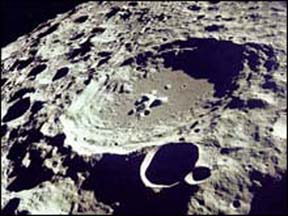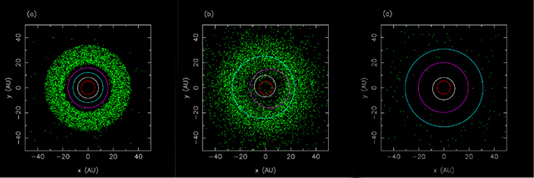Geotimes

Untitled Document

Web Extra
Tuesday, June 7, 2005
Orbital shuffle for early solar
system
From a cloud of gas and debris to a system of ordered planets with regular
orbits, much has changed since the solar system first began to coalesce about
4.5 billion years ago. Fortunately, the solar system is now full of clues to
its past, and astronomers, with the help of computer models, are finding new
ways to link together previously unconnected observations to explain how the
planetary system came to resemble what it is today.
For many years, astronomers have known that the largest of the outermost planets
— Jupiter, Saturn, Uranus and Neptune — orbit along a path that deviates
from a near-perfect circle and do not share the same orbital plane. They also
have known that several hundred asteroids either precede or follow Jupiter in
its journey around the sun. And in a third and separate observation, astronomers
have known that about 600 million years after Earth's moon formed, it experienced
a period of heavy bombardment by space debris, as evidenced by its cratered
surface. Only now have astronomers been able to connect these three mysterious
observations through a series of cosmic chain reactions.
 Reporting in a
series of papers in the May 26 Nature, Alessandro Morbidelli of the Observatoire
de la Côte d'Azur in Nice, France, and colleagues say that they have created
a model that confirms that a sudden shuffling of orbits among the giant planets,
several hundred million years after their formation, may be responsible for
the series of events. "This work is unique in the sense [that] we explain
in a level of detail no one's ever seen before," Morbidelli says.
Reporting in a
series of papers in the May 26 Nature, Alessandro Morbidelli of the Observatoire
de la Côte d'Azur in Nice, France, and colleagues say that they have created
a model that confirms that a sudden shuffling of orbits among the giant planets,
several hundred million years after their formation, may be responsible for
the series of events. "This work is unique in the sense [that] we explain
in a level of detail no one's ever seen before," Morbidelli says.
A
dramatic increase in the rate of surface cratering occured 600 million years
after the moon formed. A new hypothesis may explain why this event, among others,
took place. Image courtesy of NASA.
As the giant planets tossed around the planetesimals — debris left over
from planet formation — their orbits shifted. According to Joe Hahn, a
planetary scientist at St. Mary's University in Halifax, Nova Scotia, who wrote
an accompanying comment on the group's research in the same issue of Nature,
"the key feature is planet scattering. All the orbits get very quickly
disturbed."
Eventually the orbits of Jupiter and Saturn fell into a resonance such that
Jupiter revolved around the sun exactly twice per single revolution of Saturn.
It was this ratio, Morbidelli says, that allowed the orbital system to "come
to an abrupt change."
The researchers' model shows that the strong gravitational tugs from the orbital
resonance of Jupiter and Saturn could account for the eccentric and inclined
orbits of the large planets. And the tugs could also account for the energy
needed to kick Neptune out to a distance of twice its previous orbit, where
it remains today.
"It's just gravity," says Harold Levison of the Southwest Research
Institute in Boulder, Colo., who is a co-author of the study. "There was
a significant torque that allowed you to change eccentricities."
Neptune's ejection also sent the planet crashing into a belt of planetesimals
that had gathered at the edge of the solar system. The impact sent some of the
debris hurtling back toward the sun, an action that Morbidelli's team says could
explain the period of heavy bombardment of the inner solar system, including
Earth's moon.
But perhaps the most surprising find for Morbidelli and colleagues was their
model's ability to explain the presence of Jupiter's Trojans, the asteroids
known to join Jupiter in its orbit around the sun. "In the beginning we
weren't thinking about Trojans at all," Morbidelli says. Early works showed
that if the Trojans were "priomodial" — captured into orbit as
Jupiter formed — then the Trojans would have been lost during the orbital
shuffle. Thus, these early models must be wrong, Morbidelli says; "because
we have the Trojans."
Additional modeling revealed that some planetesimals knocked loose by Neptune's
ejection may have been captured by Jupiter's large gravitational presence. With
the increased orbital distance between Jupiter and Saturn, tugs of gravity would
not be enough to dislodge the debris from orbit. So, the model allows the Trojans
to remain in a gravitational balance, preceding or trailing Jupiter in its orbit.
"It was a gorgeous result," Morbidelli says. "We have turned
what seemed to be a weakness of our model into a strength."
 This
series of still images represent three main stages in the orbital shift model:
left, just before the shift; middle, debris scatters after Neptune is ejected,
sending rubble towards the moon; right, 200 million years later when the planets
settle down into their final orbits. AU in these graphs stands for Astronomical
units. One AU is equal to the distance from the sun to Earth. Images from an
animation courtesy of Morbidelli and colleagues.
This
series of still images represent three main stages in the orbital shift model:
left, just before the shift; middle, debris scatters after Neptune is ejected,
sending rubble towards the moon; right, 200 million years later when the planets
settle down into their final orbits. AU in these graphs stands for Astronomical
units. One AU is equal to the distance from the sun to Earth. Images from an
animation courtesy of Morbidelli and colleagues.
"I would not have expected the same model to explain both the planetary
orbits and the Trojans," Hahn says. "All these things are big plusses
in their favor. It's a compelling story."
But Hahn is not entirely convinced that the orbital rearrangement actually
took place in the early solar system. About the proposed theory, Hahn says:
"Does that mean that's the way the solar system behaved? Or is it the luck
of the model?"
Hahn says that it is difficult to prove a model of the early history of the
solar system because the evolution is not directly observable. "All we
see is the end state," he says. "But you can make your model compelling
by showing it agrees and is consistent with what we see in the solar system."
Because Morbidelli's team's model seems compatible with the constraints of
the three previously unconnected cosmic events, they remain hopeful that their
model accurately describes the processes of the early solar system. The team
continues to try to add support to their model by adding new parameters, this
time focusing on the mechanics of the debris in the disk-shaped region of planetesimals
beyond Neptune known as the Kuiper Belt. "I'm working on it as we speak,"
Levison says.
Kathryn Hansen
Geotimes intern
Links:
Alessandro
Morbidelli's home page
Animation
of orbital shift [download AVI file, 4 MB]
Back to top
Untitled Document

 Reporting in a
series of papers in the May 26 Nature, Alessandro Morbidelli of the Observatoire
de la Côte d'Azur in Nice, France, and colleagues say that they have created
a model that confirms that a sudden shuffling of orbits among the giant planets,
several hundred million years after their formation, may be responsible for
the series of events. "This work is unique in the sense [that] we explain
in a level of detail no one's ever seen before," Morbidelli says.
Reporting in a
series of papers in the May 26 Nature, Alessandro Morbidelli of the Observatoire
de la Côte d'Azur in Nice, France, and colleagues say that they have created
a model that confirms that a sudden shuffling of orbits among the giant planets,
several hundred million years after their formation, may be responsible for
the series of events. "This work is unique in the sense [that] we explain
in a level of detail no one's ever seen before," Morbidelli says.
 This
series of still images represent three main stages in the orbital shift model:
left, just before the shift; middle, debris scatters after Neptune is ejected,
sending rubble towards the moon; right, 200 million years later when the planets
settle down into their final orbits. AU in these graphs stands for Astronomical
units. One AU is equal to the distance from the sun to Earth. Images from an
This
series of still images represent three main stages in the orbital shift model:
left, just before the shift; middle, debris scatters after Neptune is ejected,
sending rubble towards the moon; right, 200 million years later when the planets
settle down into their final orbits. AU in these graphs stands for Astronomical
units. One AU is equal to the distance from the sun to Earth. Images from an
